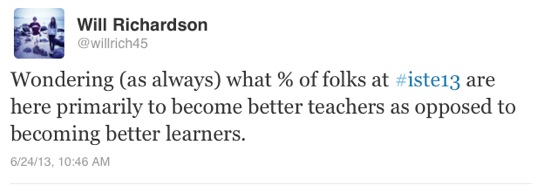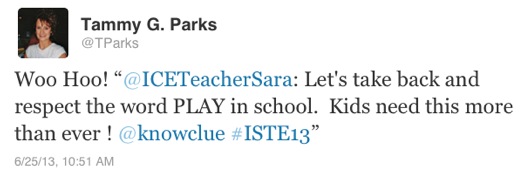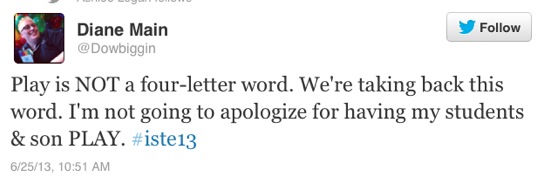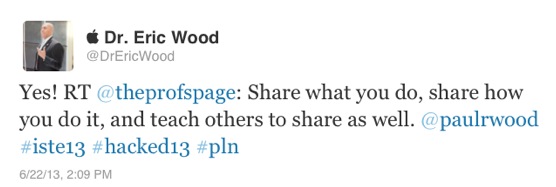I’m home and getting settled back in after the biggest ed tech conference of the year: ISTE, which was held this year in San Antonio, Texas, and attracted over 20,000 participants. I’ve already shared my notes on the inspiring ideas shared in the first Ignite session at ISTE and my summary from a session on integrating technology with limited classroom resources. This will be the last of the ISTE posts, so I’m going to cram in my big takeaways from the conference as well as a few random thoughts about how the event worked this year. Here we go!

Everyone loves Instagram.
They’re not necessarily using it as a professional tool, but as a way to quickly share what’s happening with those in their personal learning network and “real life” friends and family. I’m wavering on this one–I do really like Instagram, but am questioning whether I want to keep up with yet another form of social media.
Pinterest is gaining popularity as a way to collect and share resources.
I didn’t hear nearly as many mentions of Pinterest last year–there was still this thinking that Pinterest is for women who want to plan weddings and cute outfits. I think Pinterest is SO valuable for teachers and I’m happy to see more and more educators using it. I was also excited to learn about Adam Bellow’s new EduClipper site which is similar to Pinterest but designed for educational use and a safe place for students to explore and share resources.


Google Glass has the biggest “wow” factor amongst the ed tech crowd since the first iPhone.
There were a only a handful of beta testers for Glass at the conference, and wherever they went, you could find people sitting around in large groups passing the Glass and scanning the crowd to see where the Glass was and when it would be their turn again. I didn’t spend enough time with the product to form an intelligent opinion, but they’re less dorky and unwieldy than I thought they would be, and I’m now (slightly) less skeptical of the implications of wearing the internet on your face. Google Glass is either going to be The Next Big Thing that becomes ubiquitous and transforms the way our society functions, or it’s going to be something we look back on in five years and laugh that anyone thought something so stupid would catch on…but I’m not sure which scenario is more likely. (Any thoughts on whether Google Glass will catch on?)
The shift from tools to best practices has made major strides (or maybe I just picked better sessions this year.)
I realize my first three points in this post were about, ahem, tools, but truly, we need more practical information about using technology as part of meaningful learning. Each year, I notice sessions focusing more on the how than the what, but this was the first time I’d say that the how dominated. Judging from my Twitter stream, I think many people would disagree with me, but the sessions I attended were excellent and not at all centered around how amazing these shiny new tools are, and that’s a VERY good thing.

ISTE is less about technology and more about education reform, transformation, and 21st century learning.
Technology just so happens to be a key vehicle in the transformation process, but the focus is really on making school a place to empower kids to find and follow their passions, and that’s what makes it such a special conference. I feel like the conversations at non-ed tech conferences often get bogged down in unpacking the standards, teacher evaluation and other uninspiring topics, but ISTE is a place to exchange ideas about the possibilities in education, and what school could (and should) be like. Visionaries from all over the world attend and the level of discourse is really mind-blowing at times. That said…
The commercialization of education is far too prominent at ISTE.
It was infuriating to see how many vendors managed to throw in a plug for their products in highly inappropriate places. Some companies violated explicitly stated no self-promotion rules during events like the Hack Education smackdown (a resource-sharing time) and one of the Ignite sessions (where educators are supposed to be talking about inspirational stories and ideas.) Other vendors lurked in the blogger’s cafe and the newbie lounge, ready to sneak a product mention into a casual conversation whenever they could. I found it exhausting to be constantly discerning when I was being pitched and when I was simply hearing an educator share genuine thoughts and experiences. I spoke directly to several of these vendors and expressed my concern about their invasion of spaces that are supposed to be free from product plugs, and it was disheartening how clueless they “seemed” to be. I have my own teaching resources and books to sell, so I understand the need to make money. But just about everyone at ISTE has resources they want to promote, and doing so within the context of professional learning spaces is absolutely NOT the way to go. I find this problem far worse at tech conferences than regular ed conferences, and ISTE 2013 was a new low for product promotion, in my opinion.

My best learning still takes place in unstructured situations.
In both edcamps and the Hack Education unconference, there are no presentations or formal sessions, just opportunities for educators to get together in groups talk about topics that matter to them. These gatherings are free to attend and I can honestly say I learn just as much or more from those events than from expensive conferences. Similarly, the conversations I’ve had over dinner or just walking down the hall at ISTE had a huge impact on my learning. I attended one particular hour long session which was good but didn’t address my particular question: I spent twenty minutes grabbing some lunch with Matt Gomez and Amber Teamann (whom I know only from Twitter and conferences) and walked away with at least a dozen practical solutions for my issue. Talking with Twitter friends and others from my personal learning network (PLN) was the highlight of the conference for me, both professionally and personally.

We as teachers need to learn how to be learners again.
There was a lot of talk at ISTE about how many sessions were geared around teaching rather than learning. This is an important distinction that I know I haven’t given enough thought to. Our goal is not just to make teaching more effective, but to enhance the way students learn so it’s more meaningful to them. And that means being willing to step out of the role of the expert, and be willing to take risks and try new things.. We have to be lifelong learners ourselves and experience what it’s like to be in our students’ shoes.

Students need to hear less talking and have more time for exploration, self-directed learning, and failure.
School is set up in a way that severely and disproportionately penalizes mistakes for both teachers and kids. And yet we know that the best learning takes place through experiencing failure. I heard people talking over and over about teaching kids how to see failure as part of the learning journey and embrace their mistakes. We’re spending too much time talking at children in an effort to prevent them from making mistakes instead of presenting them with a challenge and letting them explore it. If we truly want kids to be passionate, determined life-long learners, we need to stop correcting every every error, give permission to fail, and guide kids to identify and learn from mistakes themselves.



We need to take back play and bring the fun and games back to learning.
The word play was everywhere at ISTE this year, to the delight of everyone at the conference. Early childhood educators have always preached that children learn through play, and it’s gratifying to see this concept gaining a foothold (again?) in the upper grades, as well. The “gamification of learning” (that is, having students learn through games) is a rapidly growing movement that has more and more research behind it. Since this was a technology conference, the focus was on digital games, but paper-based games are still powerful learning tools when they involve critical thinking. Having students create their own games is also an important part of gamifying learning–there are so many important higher-level thinking skills kids learn through the game creation process, not to mention life skills like persistence and how to rebound from mistakes.

Teachers don’t share their work because they don’t think they have anything remarkable to share.
There are other factors at play, of course, but we all tend to assume that what we’re doing is not as good as what everyone else is doing, and we keep it to ourselves. But the truth is that we all have things we are doing exceptionally well. We need to share what’s happening in our classrooms! George Couros said that sharing should be the default mode for educators. In his keynote, Adam Bellow went as far as saying that not sharing is selfish. The message was clear throughout the conference: there are so many ways of sharing (both online and off), and everyone has something worth contributing.


You and I are the change makers.
This is by far the most important message I heard at the conference. Yes, teaching has become increasingly challenging. But we can’t afford to wait for the tests to stop, or for principals to give us more freedom, or for the kids to come to school more prepared to learn. We can’t make excuses about what we are and aren’t allowed to do. We can’t allow aging equipment and a lack of supplies to keep us from doing the things that we know are best for kids. You and I are capable of creating change, starting with the students we work with each day. Change does not come from policy makers alone: it comes from touching the lives of individuals. That is something that every single one of us can do, starting right now. The work we do in the classroom matters, and it’s the place where real and transformational change begins.
There were so many great insights shared via Twitter–be sure to check out EdTech Magazine’s round up of some of the best tweets from ISTE. I’d love to hear your thoughts: if you were at ISTE and blogged about it, feel free to leave a link in the comments. If you weren’t at ISTE, let us know what you think of these ideas. In what settings does your best learning take place? How do you share the great things that are happening in your classroom?

Angela Watson
Founder and Writer
Discussion
Leave a Reply
OR

Join our
community
of educators
If you are a teacher who is interested in contributing to the Truth for Teachers website, please click here for more information.
















Angela,
Thank you! I went back to school to become a teacher. I earned my Master’s and now I’m trying to become the teacher you talk about. It’s frustrating but I know it will be worth it once I get that first position.
Nancy
You’re welcome, Nancy!
Wow-za, Angela! Each one of those points could have been a blog post in itself. Thanks so much for great info and insights.
I didn’t attend ISTE this year partly because of the fear of it being too focused on consumerism and the latest toy instead of the best practice. Looks like it was worth it for you. Good to hear.
– @newfirewithin
LOL, thanks, Justin–I agree, I really wanted to write more about each point.
I am considering skipping ISTE next year for the exact reasons you mentioned. I feel like I need some reassurance that more boundaries will be drawn for vendors before I subject myself to that experience again. I’m not sure what that would even look like–obviously there is no ISTE Learning Defense Force–but I figured I could do my part by speaking out publicly about what I noticed.
Great post and review of the conference, Angela! You truly made me wish I had been there- and that’s really saying something, considering I have been to something like “umpteen” educational conferences this year!
Thank you for a great article!
Heidi Butkus
I appreciate that, Heidi! Glad I was able to bring some useful info back for you.
Thank you for giving everyone a glimpse into a conference that is not accessible for all. I agree with the many comments on what you observed. My husband is in the engineering field (as I was many years ago before I went into teaching) and we discussed one big difference between teaching and other professions- real teachers want to help ALL students, not just their own. Therefore, teachers want to help other teachers. We do NOT become teachers for the money. Other professionals choose a profession for the highest pay possible that uses an individual’s particular talents. That said, I wish we had one web site that all teachers could use for sharing ideas and getting questions answered. Again, thank you for sharing your experience.
Powerfully said, Yvonne!
In terms of having one website for all teachers to use for sharing ideas and getting questions answered, I’d say Twitter. So much of my professional learning happens there.
And by following professional updated learning blogs like yours. I didn’t attend ISTE this year but I just got a great glimpse of the new ISTE focus. Thank you for taking the time to share your observations.
I really liked how you said that technology is a “key vehicle” in changing our schools and making them better. I agree. I also know it’s not the only thing. But it is a major one. I hear teachers around me say they don’t have time for all this new technology and they don’t work to change their practices because what they’ve always done has always worked. It’s hard to listen to them. I wish they could see the endless possibilities and how easy technology integration really is. Glad you enjoyed San Antonio! It’s one of my husband’s favorite vacation spots!
Hi, Shibahn! It’s always interesting to me when people say they’re doing what’s always worked and don’t need to try new things, because they’re usually the first people to complain that kids today are bored, unfocused, lazy, uninterested in learning, etc. If that’s a teacher’s experience, I think it’s safe to say that doing what they’ve always done is NOT working! 🙂